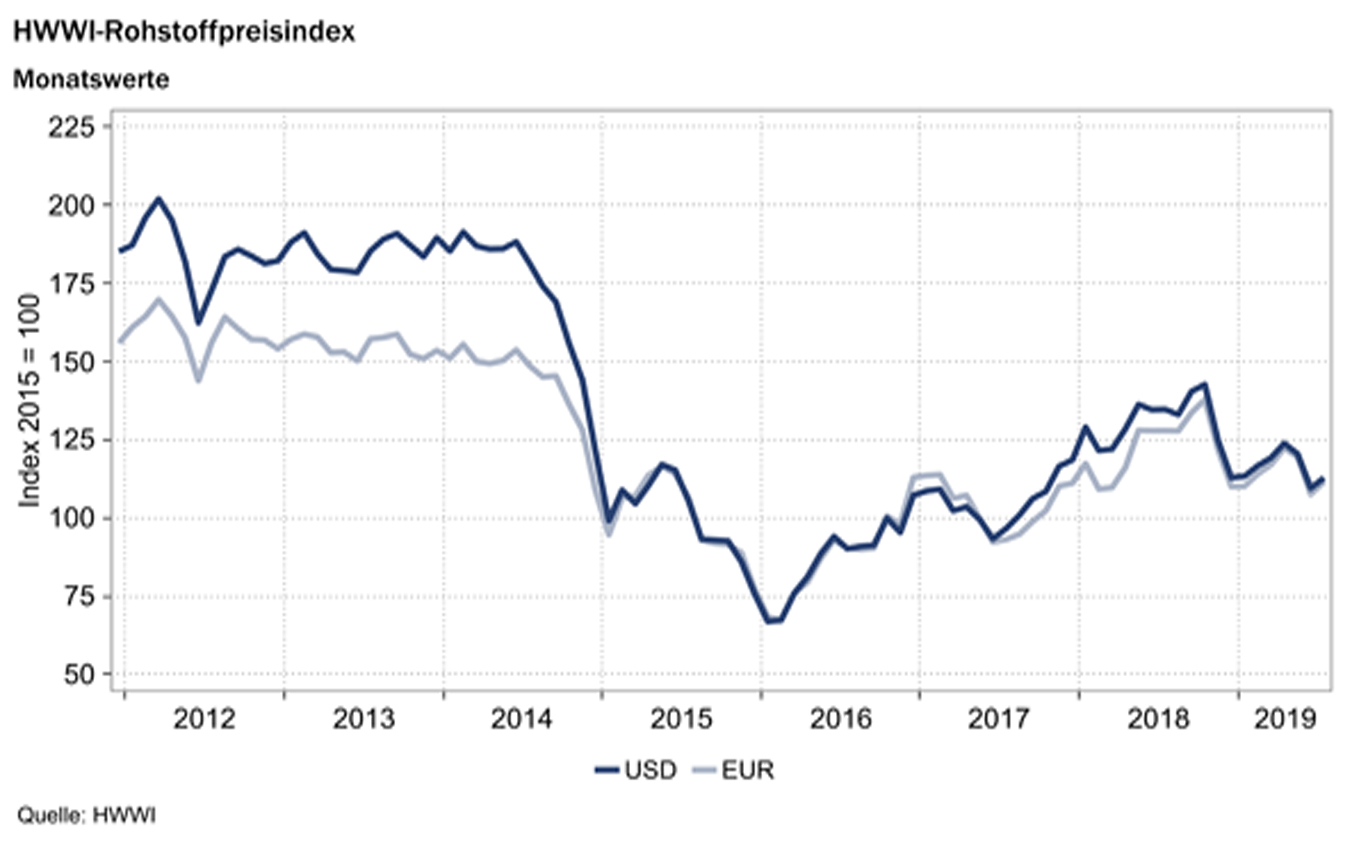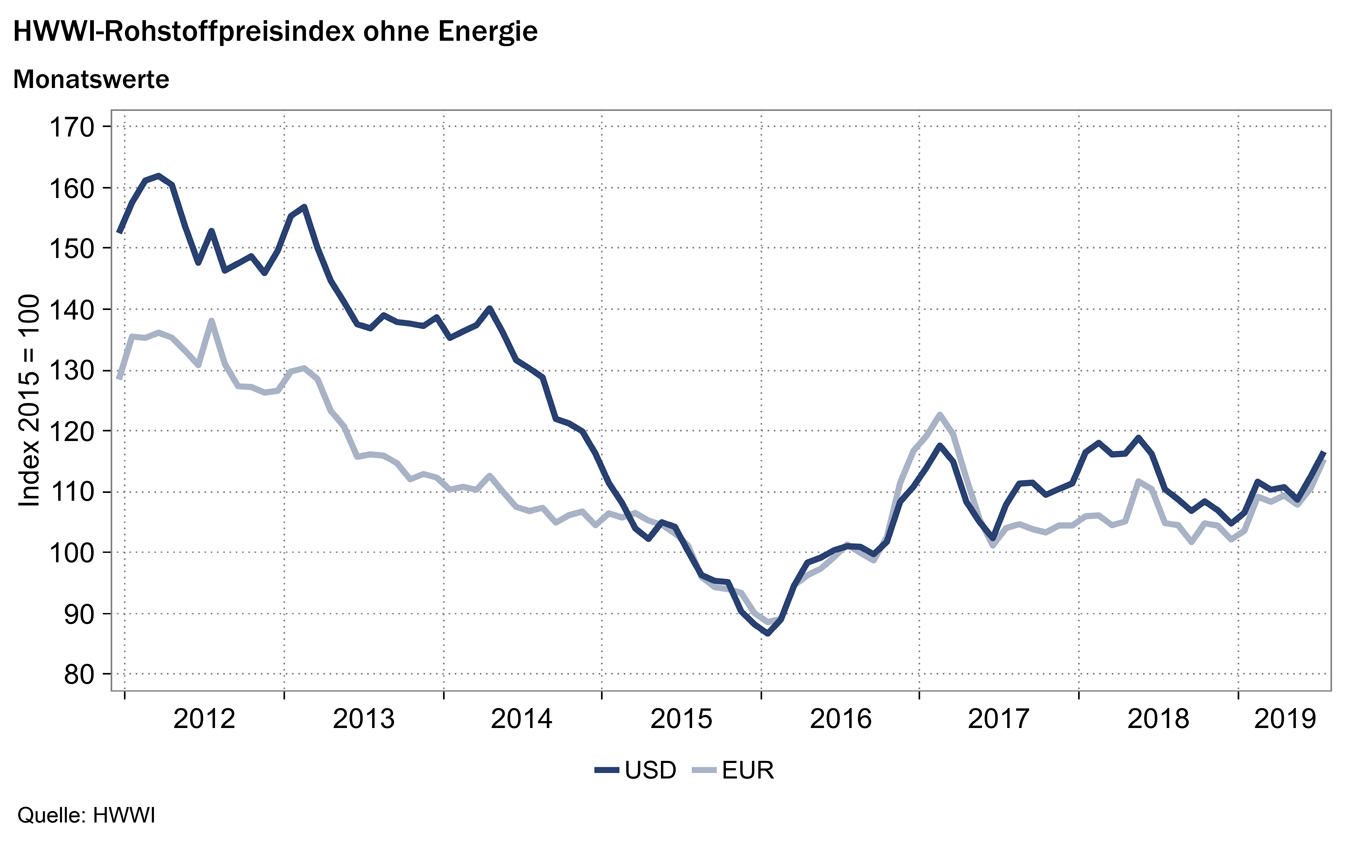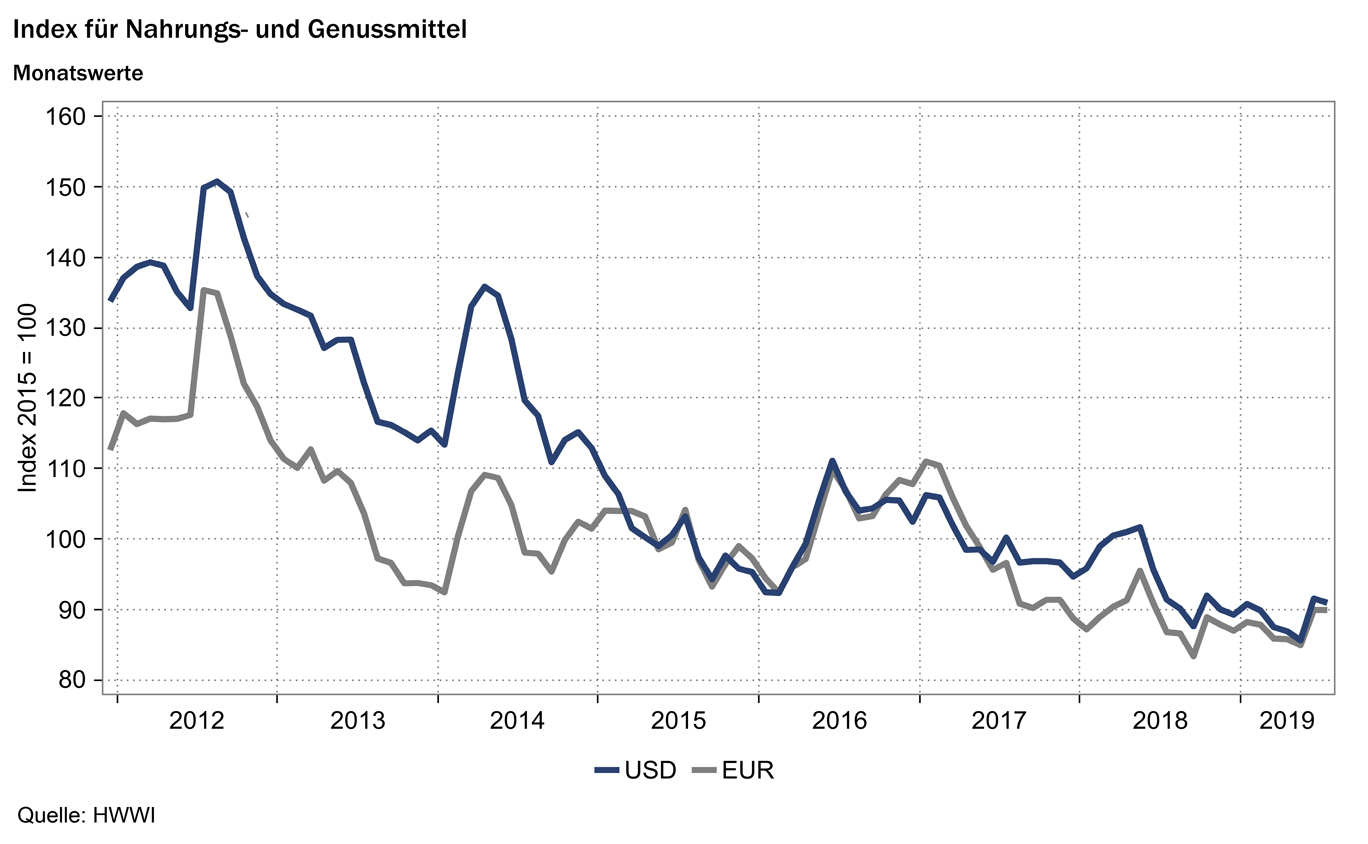HWWI commodity price index rose for the first time after two months
- HWWI Total index increased by 3.0% (US dollar basis).
- Crude oil increased by 3.2%.
- Index for Food total fell by 0.7%
(Hamburg, August 16, 2019) In July, the HWWI commodity price index rose on aver-age by 3.0% (in Euro: + 3.7%) compared to the previous month. The composite index thus reached a level of 112.8 points in July (in Euros: 111.5 points). An increase of 5.8% (in Euro: + 6.5%) was recorded for the index for Industrial raw materials, while the index for Energy raw materials only increased by 2.9% (in Euro: + 3.6%). The in-dex for food and beverages fell by 0.7% (in Euro: ± 0.0%), following a significant in-crease in June. The index excluding energy rose in July by 3.3% (in Euro: + 4.0%) compared to the previous month and stands at 116.6 points (in Euros: 115.4 points)

Index for Energy raw materials: + 2.9% (in Euro: + 3.9%)
In July, the weighted price of crude oil rose on average by 3.2% (in Euro: +3.9%) to $ 61.77 (€ 55.06) per barrel, even though the uncertainty about the global economy continues to dominate the markets. On the one hand, the trade dispute between China and the USA put pressure on crude oil prices. On the other hand, the increas-ing conflict in the Strait of Hormuz created uncertainty in the security of supply of world markets, especially China. At the beginning of the month, OPEC + agreed to extend the 1.2 million barrel per day reduction until March 2020. This announcement raised prices on the crude oil market. In detail, the price increase for the US crude oil grade WTI was the strongest. The expansion of pipeline capacity increased exports of US crude oil. This reduced the price difference to other reference varieties. Com-pared with the previous month, the price of WTI rose by 5.0% (in Euro: + 5.7%). Crude oil from the Middle East, the Dubai variety, rose by 2.9% (in Euro: + 3.6%). The lowest price increase was recorded for Brent European crude oil. It rose by 2.0% (in Euro: 2.7%).
No change from the previous month was found for the weighted average price of nat-ural gas. Accordingly, the change amounted to ± 0% (in Euro: + 0.6%), with Euro-pean natural gas becoming more expensive and US natural gas becoming cheaper. The price of European natural gas rose by a monthly average of 1.9% (in Euro: + 2.6%). The US natural gas price fell by 1.2% (in Euro: + 2.6%). The price of coal rose by 2.9% (in Euro: + 3.6%). Overall, the index for energy commodities rose by 2.9% in July (+ 3.6% in Euro) to 112.2 points (in Euro: 110.9 points).

Index for Industrial raw materials: +5.8 % (in Euro: +6.5 %)
The index for industrial raw materials is divided into the index for agrarian raw materi-als, the index for non-ferrous metals as well as the index for iron ore and steel scrap. In July, the index for agrarian commodities fell by 0.3% (in Euro: + 0.3% rose). The rubber price fell by 6.1% (in Euros: -5.4%). The trade conflict between the US and China is weighing on global trade. Demand for rubber declined as Chinese tire pro-duction declined year-on-year. In addition, the relatively low price of crude oil weighed on the price of rubber, as the production of synthetic rubber is cheaper. Lumber increased by 9.2% (in Euro: +10.0%). The non-ferrous metals index rose by 2.0% (in Euro: + 2.7%). On a monthly average, prices of zinc and tin fell by 6.1% (in Euros: -5.5%). The expansion of Chinese zinc production and the reopening of the Australian mine Lady Loretta, as well as production increases at the McArthur River Mine, also in Australia, led to lower zinc prices. By contrast, nickel became signifi-cantly more expensive. The nickel price rose by 12.3% (in Euro: +13.1%) due to low inventories. The lead price rose by 4.4% (in Euro: + 5.1%). Aluminum increased by 2.1% (in Euro: + 2.8%), and the copper price rose moderately by 1.1% (in Euro: + 1.8%).
The index for iron ore and steel scrap rose again, with the increase of 13.3% (in Euro: + 14.1%) even more pronounced than in the previous month. Since the first quarter of this year, iron ore’s supply has been constrained by the impact of the mine disaster in Brazil and the after-effects of Cyclone Veronica in Australia, with a simul-taneous increase in demand from mainly Asian countries. The increased iron ore price is opposed by the lower price for steel scrap. Steel scrap is needed for the pro-duction of steel. Falling steel prices lower the production of steel and thus the de-mand for steel scrap. In July, the index for industrial raw materials rose by 5.8% (in Euro: + 6.5%) to 134.5 points (in Euro: 133.1 points).
Index for Food total: -0.7% (in Euros: ± 0.0%)
In July, there was a mixed picture in the price development of the commodities for food and beverages represented within the index. While prices for barley, soya, coco-nut, sunflower oil, tea, coffee and cocoa rose, prices for corn, rice, wheat, soybeans, soybean meal, palm oil and sugar fell. The price increase for coffee averaged 3.2% for the month (+ 3.8% in Euro), peaking at the beginning of the month but falling later in the month. The expected demand was stronger than the expected harvests, but
high stocks of coffee are available. The price increase of cocoa was moderate. Co-coa increased by 0.4% (in Euro: + 1.0%). Among the cereals, the price reduction for wheat was the most pronounced at 5.3% (in Euro: -4.7%). Greater acreage and in-creases in wheat harvests and a strong US dollar lowered the price of wheat. Overall, the index for Food total fell in July by 0.7% (in Euro: ± 0.0%) to 90.9 points (in Euros: 89.9 points).

